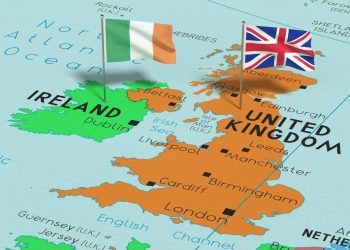Recent findings from the Annual Survey of Hours and Earnings, diligently curated by the Northern Ireland Statistics and Research Agency, offer a comprehensive view of Northern Ireland’s economic landscape. This analysis exposes a troubling trend, highlighting the region, spanning from Causeway Coast and Glens to Belfast, as a central hub for low wages across the UK and Ireland. A closer examination of the data reveals the multifaceted nature of Northern Ireland’s economic hurdles, encapsulating issues related to hourly wages, gender pay disparities, and broader income inequality concerns.
Sinn Féin’s Assertions about Northern Ireland’s Economic Landscape
Amidst the intricate tapestry of economic data and regional dynamics in Northern Ireland, Sinn Féin has positioned itself as a vocal commentator, making bold assertions about the region’s economic standing. The claims put forth by Sinn Féin in the run-up to the 2023 local government elections paint a stark picture of Northern Ireland, alleging that it holds unenviable titles such as having the lowest wages, slowest economy, lowest productivity, and highest economic inactivity in the UK and Ireland.
One of the focal points of Sinn Féin’s claims revolves around Northern Ireland’s status as the low-pay hub of the UK and Ireland. The party’s assertion regarding the region’s economic challenges, particularly emphasising low wages, has become a significant part of Northern Ireland’s economic narrative discourse.
While Sinn Féin’s claims have undoubtedly sparked attention and discussions, subjecting them to scrutiny in light of the nuanced realities revealed by sources such as the Annual Survey of Hours and Earnings (ASHE) and other economic indicators is crucial. Hourly wages, gender pay gaps, and disparities between public and private sector earnings offer a more complex picture beyond a singular characterization of Northern Ireland as a low-pay centre.
Regional Disparities and Economic Growth
Distinctive regional disparities and a complex trajectory of economic growth mark the economic landscape of Northern Ireland. While certain narratives position the region as a low-pay hub, a closer examination reveals nuanced patterns that extend beyond wage considerations.
It is essential to dissect these regional disparities further to understand the intricate dynamics shaping economic growth. Despite facing challenges, the ASHE data indicates that Northern Ireland is the fifth lowest-paid region among the 12 UK regions. This ranking suggests a struggle to bridge the gap with higher-earning regions like London.
Comparisons with the Republic of Ireland add a layer of complexity. While typical full-time pay in the Republic is approximately 10% higher in cash, the relative purchasing power of these wages on each side of the border remains a critical factor. Economic policies, social structures, and living costs contribute to the intricate web of regional disparities.
The economic growth metrics, such as the NI Composite Economic Index (NICEI) and model-based estimates of regional Gross Value Added (GVA), introduce further complexity to the narrative. While some indicators suggest lower growth for Northern Ireland, the lack of consistent patterns makes it challenging to unequivocally label the region as having the lowest economic growth.
Hourly Wages in Northern Ireland
Hourly wages are a pivotal indicator of economic well-being, and the intricacies of comparing these wages across regions reveal a nuanced reality. The Office for National Statistics (ONS) employs full-time employees’ median gross weekly earnings as a more reliable measure than the mean average.
In 2022, Northern Ireland ranked third-lowest among the 12 UK regions, with a median weekly pay of £592, surpassing only the North East of England (£575) and Yorkshire and the Humber (£579). Northern Ireland’s median annual earnings, delving deeper into international comparisons, were notably lower than those in the Republic of Ireland, further complicating the regional economic narrative.
Unveiling Salary Disparities and Long-Term Trends in Northern Ireland
Gender Pay Gap
While Northern Ireland stands out as the only region in the UK where full-time female workers earn more on average than their male counterparts, the broader gender pay gap remains a concern, including both full-time and part-time workers.
The nuanced data reveals that, despite this unique scenario, the gender pay gap increased to 7.8% in favour of males in 2023.
These dynamics highlight the need for a comprehensive understanding of gender-based wage differentials within the region.
Public Sector Pay Decline
The ASHE figures underscore a pronounced decline in real pay for public sector workers in Northern Ireland, with an average full-time public sector worker experiencing a 7% drop in real pay over the past year. This alarming trend has spurred industrial action, with strikes and protests against perceived inadequate pay settlements gaining momentum.
Private Sector Contrasts
While private sector workers witnessed a more favourable trajectory, with a 1.4% rise in typical full-time pay in real terms, disparities persisted across sectors.
Notably, the financial services sector saw an 11% decrease in real pay. The narrowing gap between public and private sector pay, with public sector earnings now only 22% higher than their private sector counterparts, marks a significant departure from historical trends.
Long-Term Trends
The ASHE data, examining two decades’ trends, illustrates a stagnation in real earnings within the public sector for the last 20 years, sharply juxtaposed with a 13% rise in the private sector. This challenges conventional notions of a public sector premium, highlighting a shift in the economic landscape of Northern Ireland.
Northern Ireland’s Economic Reality
Hourly wages, gender pay gaps, and the intricate dance between public and private sector earnings reveal a complex web of factors shaping the economic reality of Northern Ireland. While the region faces challenges, particularly regarding wage disparities and the decline in real pay for public sector workers, it also displays resilience, as demonstrated by its economic performance during the pandemic.
The regional disparities within Northern Ireland, coupled with comparisons to the Republic of Ireland and the broader UK, underscore the multifaceted nature of its economic journey. Striking a balance between acknowledging wage disparities and recognizing positive growth trends is essential for a holistic understanding of the region’s economic trajectory.
As Northern Ireland continues to navigate its economic path, policymakers face the challenge of addressing these complexities. The need for targeted interventions to uplift lower-wage sectors, close gender pay gaps, and foster equitable economic growth is evident.





























